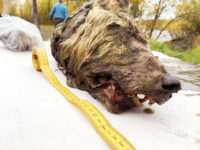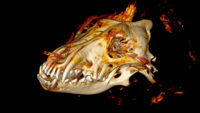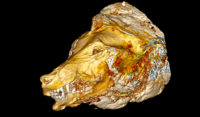 The perfectly preserved decapitated head of a Pleistocene wolf has been found above the Arctic Circle north of Yakutia, Siberia. It was discovered last summer by Pavel Efimov on shore of the Tirekhtyakh River, but the find was only announced this week at the opening of a Woolly Mammoth exhibition in Tokyo.
The perfectly preserved decapitated head of a Pleistocene wolf has been found above the Arctic Circle north of Yakutia, Siberia. It was discovered last summer by Pavel Efimov on shore of the Tirekhtyakh River, but the find was only announced this week at the opening of a Woolly Mammoth exhibition in Tokyo.
The soft tissue is in excellent condition. Muscles, brain, fur, skin are all intact, preserved for 40,000 years in the Siberian permafrost. The fur is very thick, described by researchers as “mammoth-like.” It is brown now, giving rise to questions from the public that it looks more like a bear rather than a wolf. That was not its original coloring; its an effect of burial in the permafrost which has permanently altered the fur’s color. Even if the fur were thoroughly washed, it would still look brown, and there’s no way to determine the original color.
 The wolf was a fully grown adult between two and four years old when it died, and was rather petite compared to most modern wolves. The head is 40cm (15.7″) long. The head of modern Arctic wolves varies in length from 66cm to 86cm (26-34″). Interestingly, a CT scan of the head revealed that some parts of the skull are more developed than those areas are in the skulls of today’s wolves.
The wolf was a fully grown adult between two and four years old when it died, and was rather petite compared to most modern wolves. The head is 40cm (15.7″) long. The head of modern Arctic wolves varies in length from 66cm to 86cm (26-34″). Interestingly, a CT scan of the head revealed that some parts of the skull are more developed than those areas are in the skulls of today’s wolves.
“This is a unique discovery of the first ever remains of a fully grown Pleistocene wolf with its tissue preserved. We will be comparing it to modern-day wolves to understand how the species has evolved and to reconstruct its appearance,” said an excited Albert Protopopov, from the Republic of Sakha Academy of Sciences.
 How the wolf’s head became detached from its body is unknown, but it was almost certainly not cut off by people as there is no evidence humans inhabited the gelid region 40,000 years ago. Its likely that it was severed by ice. Expanding ice often beheads dead animals trapped in it, leaving characteristic traces on the soft tissue. Researchers in this area have seen this phenomenon at work. The ice acts like an axe or a knife, cutting cleanly through necks. It’s possible some other force was involved in the decapitation of this wolf, however, because the cut is more ragged than ice expansion cuts usually are. A trace expert will be called in to examine specimens taken from the sever point under a microscope.
How the wolf’s head became detached from its body is unknown, but it was almost certainly not cut off by people as there is no evidence humans inhabited the gelid region 40,000 years ago. Its likely that it was severed by ice. Expanding ice often beheads dead animals trapped in it, leaving characteristic traces on the soft tissue. Researchers in this area have seen this phenomenon at work. The ice acts like an axe or a knife, cutting cleanly through necks. It’s possible some other force was involved in the decapitation of this wolf, however, because the cut is more ragged than ice expansion cuts usually are. A trace expert will be called in to examine specimens taken from the sever point under a microscope.
No other parts of the wolf have been found so far. Researchers plan to visit the find site to excavate it looking for additional remains.
Here’s a brief but amazing video of the head being turned and examined by researchers: